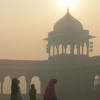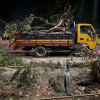Metrophilia: How to Love Dhaka

If you want to fall in love with the city, walk. This simple aphorism opens up a full discourse on how we can make our cities liveable and civic, and how we might live together as a collective. One needs to love a city to plan it – this perhaps could be a second aphorism. A better philosophy for urban development – what The Daily Star asked me to write on – should be based on an ambulatory life, in living and experiencing the city by walking. In walking, we are with others and we participate in what can be described as the public realm.
The city has become unbelievably complex and impenetrable, but it is also a beautiful thing, as the former mayor of the model Brazilian city Curitiba always reminds me. As the "most beautiful collective dream," Lerner implores, the city is not a problem, but the solution to collective existence.
French writer Charles Baudelaire celebrated the ritual of walking in the city in the form of the flaneur. A difficult word to translate from French, as it might mean a loafer as we say in Dhaka, but in Baudelaire's sense, a flaneur is "a connoisseur of the street," an alert investigator who in wandering the streets takes in the sights, sounds and spirit of the place. Inspired by city life, Baudelaire's flaneur can become a productive person. Architect Louis Kahn imagined the street as a place of infinite wonderment, where a child while walking one day decides what she wants to do with her life.
In the 1960s, the Situationists, the avant-garde group based in Paris, proposed the practice of dérive that involved journeying the terrain of a city to randomly discover situations in which to enact unprecedented work of political art. Psychogeography, the practice of walking and mapping the city, developed from there. In a moving essay called the "Dictionary of Streets," published in his book Beginning with My Streets, Polish writer and Nobel laureate Czeslaw Milosz intersects a psychological geography with the lay of the city streets in his hometown Wilno (Vilnius), so that the "aura of the place" may be recorded.

Writing in his book The New York Nobody Knows, sociology professor William Helmreich mentions walking almost every street in New York City, which would be about 6,000 miles. "I love to read about the city, to live in the city, to walk the city." Helmreich confesses in a New Yorker article. "I did it in the morning. I did it in the evening. I did it on the weekends. I did it in the rain, in the snow, in the summer. It came to about thirty-five, forty miles a week, a hundred twenty a month, fifteen hundred a year." I know architect Salauddin Ahmed, who takes off very early in the morning to walk the streets of Dhaka and document its life-world.
A good city is, above all, a walkable city – this is an axiomatic truth propagated by ardent lovers of the city, from Baudelaire to biologist-planner Patrick Geddes, and urban activist Jane Jacobs to sociologist Henre Lefebvre. Our most intimate engagement with the city is in walking. I describe this phenomenon as "metrophilia." As a notion, this is not found in the training of planners and architects in the country, and certainly not enshrined in the thick policy books produced for planning cities.
A walking environment should be the number one priority in any transport or urban planning. In our cultural schema, we prioritise the movement of motorised vehicles, and place the pedestrian at the lowest level of all policymaking and infrastructure planning. We overlook the fact that, of the people on the move in the city, 40 percent walk. Where once the pedestrian ruled, and the city was a place for walking and meandering, and enjoying its footpaths, riverbanks and public spaces, now the automobile dictates the term of organising the city. We make roads for cars, and direct all major investments – elevated roads, flyovers, ever wider roads, and U-loops – to the promise of an uninterrupted vehicular movement, while we corner the pedestrian to the ever-shrinking edge of the road.

And that is why the footpaths of Dhaka remain the saddest configuration ever suggested for human adaptation. Primarily constructed as cover for drains, most footpaths are ironically unwalkable: they are broken into segments, they are obscenely high (sometimes requiring steps to climb up!), and when they do exist, they are often taken over by electric transformers, bus ticket vendors and police boxes. There, the walkers topple over one another, and hopscotch and jump on a ragtag space not more than four feet wide. No wonder people walk on vehicular roads even at the risk of being run over. With the book Designing Dhaka, published in 2012, we may have been the first to raise concern about the poor and shabby footpaths in the city. We even joked: a footpath is exactly that – a-foot-wide path!
Despite heavy investments on the road, we have not been able to give a civic form and norm to it. Dhaka still has a rudimentary road and transportation system. Clogged, cluttered and chaotic, the roads of Dhaka are like scenes from a disaster movie. If after thousands of years of human civilisation, we crawl on our roads in our vehicles at seven kilometres per hour – the average speed of a motorised vehicle on Dhaka roads – and some of us who are walking meet untimely deaths by being run over, there is something wrong with the image of development.
If we wish for this megacity of 20 million residents to be a shining capital of a developed nation, marching forward with its flag of ever higher GDP, we should start from city roads. Economic advancement should match the quality of urban and physical spaces in our cities.
I have emphasised elsewhere that the road in the city is really a public landscape, a space shared by both motor vehicles and humans – one is a mechanised contraption moving with a speed, and the other a vulnerable living, breathing being. The road is not merely a conduit for movement of motorised vehicles; it includes passage, movement and crossing for pedestrians. In Dhaka, we forget that the pedestrian is a vulnerable human being, whose five-foot-three-inch stature provides the fundamental scale and reference for all spaces.
The real problem is that Dhaka city – as is – resists walking, and hence our ambivalence about the city itself. The middle, upper-middle and upper classes (MUMU) in Dhaka do not walk! Finding walking and thus becoming the public a discomfort, they are happily ensconced in their houses/flats. Removed from the public domain, they move in their car capsules to go from one space capsule (home) to another (home or work). With the MUMU class calling the shots on the lay of the city (they influence most policy decisions one way or another), and holding a disdain for the "public," we will not expect any improvement of the public realm and public spaces any time soon.

One major public-oriented enterprise that is late in coming, but certainly crucial in improving the liveability of the city, is the Mass Rapid Transit (MRT). We all look forward to that. With all the construction going on around the MRT, we have not yet seen much thought on walkability as it is critically linked to the success of any rapid transit. All major cities with successful MRTs – Tokyo, Moscow, NYC, Hong Kong – are supremely walkable. What is needed along with the transit infrastructure plan is a "walkability plan" for Dhaka; the transit-oriented metropolitan scale must match up with the walkable local scale.
In times of Covid, the importance of open, public spaces and recognition of the local have become a dire public health necessity. Nearly all conscientious cities of the world focused their attention on the significance of public spaces, and the importance of walkable city hubs. Many cities in the US have adopted what is known as "open, slow or shared" streets in which the presence of the automobile has been curtailed or controlled to provide open-air mini public spaces. A new call for action for European cities is the "Fifteen Minutes City," being popularised by the mayor of Paris, Anne Hidalgo, in which most needs of the people will be catered to in a fifteen-minute walkable neighbourhood. In advancing the idea of the hyper-local, and allowing citizens to use the streets in their own way, Stockholm is testing the idea of a "one-minute city."
Dhaka is yet to present convincing initiatives for such public spaces. Urban or settlement design and landscape design – two critical areas for making our environments better – are sadly missing in the training of our environmental professionals, and starkly absent in the official discourse on urban planning. In the meantime, designers of apartment buildings and commercial structures, with quasi-artistic effects and gestures, are conducting urban planning with no grounding in the theory of cities or the methods of urban design.
I have also argued that, in improving the public and civic life of a city, it is more important to think in terms of "urbanism," that is, the dynamic and positive turns of a city with its multi-scalar realities, and not urbanisation, which has come to mean only the dire and uncontrollable side. Urbanism can be approached only by urban design. In his new book, The Largest Art: A Measured Manifesto for a Plural Urbanism, Brent Ryan, a professor at MIT, describes urban design as the "largest art" in human culture that addresses the plurality and multiple scalarity of our cities. Such approaches require a distinctive understanding and knowledge of cities, something that cannot be equated by the limiting methods of architectural design or the dry policy orientation of planning.
Despite being a city of disparities and chaos, and choked by urbanisation, Dhaka also functions. The city works because the formal and informal, and the structured and spontaneous coexist in a kind of quiet truce. That truce is maintained literally at the walls of plots and properties of Dhaka!
The public realm of Dhaka is a paradox, in which the wall as a structural, spatial and signifying element remains decisive and divisive in basic social transactions. Once Dhaka was a city of "mosques and bazaars," now it is a city of walls and boundaries. In 2016, Bengal Institute associates investigated a 410-acre planned residential area in Dhaka, and calculated that if all walls around the plots are lined up, it would be more than 300 miles long. From Dhaka, it would reach Chattogram. Bengal Institute also studied what would materialise if walls along institutional and commercial plots were dematerialised or reduced – it would bring about an amazing new quality to the public realm, and allow for a more inclusive experience of the collective.

The walls of Dhaka city constitute a "meta-site" against which the "unregistered" collectivity is practised. A short walk through any of the streets of the city reveals the resiliency of its citizens – in how one meets ends and perhaps brings about meaningful and joyous elements. The walls provide a spatial reference and opportunity against which actual situationist and tactical operations are conducted. Such operations may be subversive to city ordinances, but for many tea stands, shoe repair spots and nursery-wallas – I once saw a young woman with a sewing machine carrying on the trade of a tailor at a footpath intersection – are ways of inhabiting and negotiating life in the city at the smallest and invisible scale. These operations may be described as micro-urbanism.
While such tactics may mark a contestation between legal and illegal operations in the conventional terms, one also discovers conditions of ingenuity, craft (craftiness!), and skill that are conducted spatially as acts of design. Somewhere in the middle, between the invisible micro-urbanists and the loud planners and designers, there may be a fruitful transaction in making the spaces of the city more civic and accessible.
Kazi Khaleed Ashraf is an architect and urbanist, and author of Designing Dhaka: A Manifesto for a Better City. He directs the Bengal Institute for Architecture, Landscapes and Settlements.

 For all latest news, follow The Daily Star's Google News channel.
For all latest news, follow The Daily Star's Google News channel. 








Comments